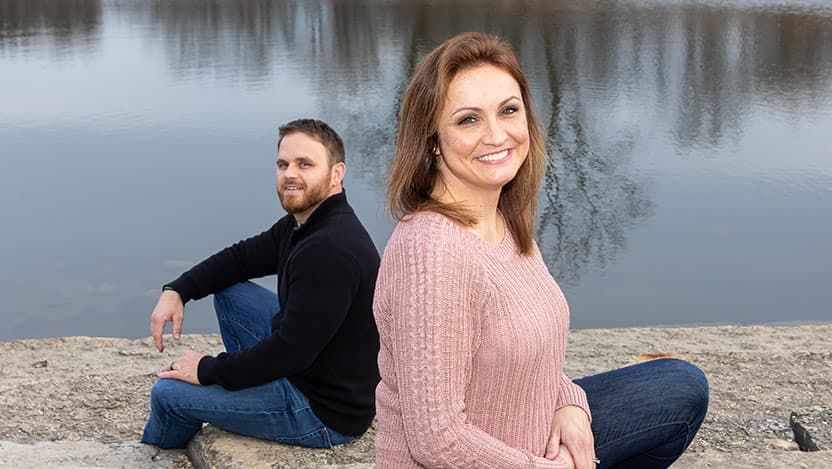Living liver donation: The gift of a lifetime

Kristen Batkiewicz’s brother, Jason, donated a part of his liver to his sister.
In April 2019, Kristen Batkiewicz’s husband, parents and siblings gathered in a conference room at the University of Chicago Medicine for an update on her health. Her liver was failing, but because she was otherwise healthy, the 37-year-old sixth grade teacher was not high on the waiting list for a new organ.
Liver disease specialist Helen Te, MD, explained that if Kristen’s health declined during a long wait for a donor, the odds of a successful transplant would be lower. A living donation from a relative or friend could save her life.
Kristen resisted the idea of a family member or friend donating part of a liver. “It’s not like you are asking for a simple favor, or to borrow something,” she said. “You are asking someone to undergo major surgery and recovery for you.”
Several relatives and friends volunteered to be tested as potential donors.
Giving a ‘second chance to live’
More than 13,000 people are on the waiting list for a new liver in this country. Because the need for donor organs far exceeds the number of livers available for transplant, about 1,500 Americans die each year while waiting.
In 1989, UChicago Medicine performed the first living donor liver transplant in the U.S., the first successful transplant of its kind in the world.
A living donation is another transplant option for patients with severe liver disease.
Due to the liver’s unique ability to regenerate (grow back), a living donor can safely give a part of his or her healthy liver to a family member, friend or even a stranger.
Deciding to donate
Kristen’s younger brother, Jason Korkosz, met the preliminary criteria — matching blood type, between the ages of 18 and 55, and healthy — to be her donor.
Jason had watched his sister’s health worsen over several years as a result of primary sclerosing cholangitis (PSC). The progressive disease causes inflammation and scarring of the bile ducts, which carry digestive fluids (bile) from the liver to the gallbladder. Over time, bile builds up and damages the liver, eventually causing it to fail.
“Kristen was in and out of the hospital every two to three months,” Jason said. “Her quality of life was not good.”
He underwent imaging tests to assess the quality of his liver. He also met with members of the liver transplant team to rule out any potential barriers — medical, surgical, psychological or social — that would preclude him from being a living donor. The high school physical education teacher and football coach was deemed a perfect candidate.

Jason, who considers himself a careful person, weighed the potential complications of the surgery, which are similar to the risks associated with any major surgery. “Then I thought about my sister and her young daughter,” he said. “I made my decision, and that was it.”
Separate but together
Just before their surgeries, Kristen told Jason that she wasn’t afraid, just excited to start a better life. “I have never witnessed someone so brave,” he said.
Kristen gave her brother one of their grandfather’s Army ribbons, which he had given to her as she struggled with being so sick. “He deserves to have it back, because he is the hero," she said.
On the morning on October 29, 2019, the siblings from the southwest suburbs hugged before Jason was taken into the operating room. Liver transplant surgeons performed the surgery to remove the right lobe of his liver — about two-thirds of the organ. The two-step “hybrid” procedure combined a minimally invasive laparoscopic technique with open surgery to reduce postoperative pain, risk of complications and recovery time.
Chronic pain and fatigue had become my norm. With a new liver, I felt healthy and energized for the first time in a long time.
In an operating room down the hall, transplant surgeons John Fung, MD, PhD, removed Kristen’s diseased liver and replaced it with the Jason’s healthy lobe.
The two patients recovered from surgery on the same floor of the hospital, but at opposite ends. “The transplant team did this intentionally so we had to walk to see each other,” Kristen said. “Jason came to my room often to check on me and encourage me. We watched lots of football games and Netflix shows together.”
Both reported feeling much better by the end of 2019. Jason went back to work in January. By that time, his liver had grown back to 90% of its original size. Kristen, who had taken a medical leave for the school year, is now teaching again, remotely due to COVID-19.
Kristen didn’t realize how sick she had been until after the transplant. “Chronic pain and fatigue had become my norm,” she said. “With a new liver, I felt healthy and energized for the first time in a long time."
“To say UChicago Medicine is at the forefront of medicine is an understatement. I’ve had many serious issues with this disease, and each time my medical team was available and ready with an answer — in this case with the living donor liver transplant that saved my life. I will be forever grateful.”
How to Find a Living Organ Donor
Seeking a living organ donor can raise feelings of discomfort and even embarrassment in many transplant patients. These tips can help you plan your search.
Read the full article
